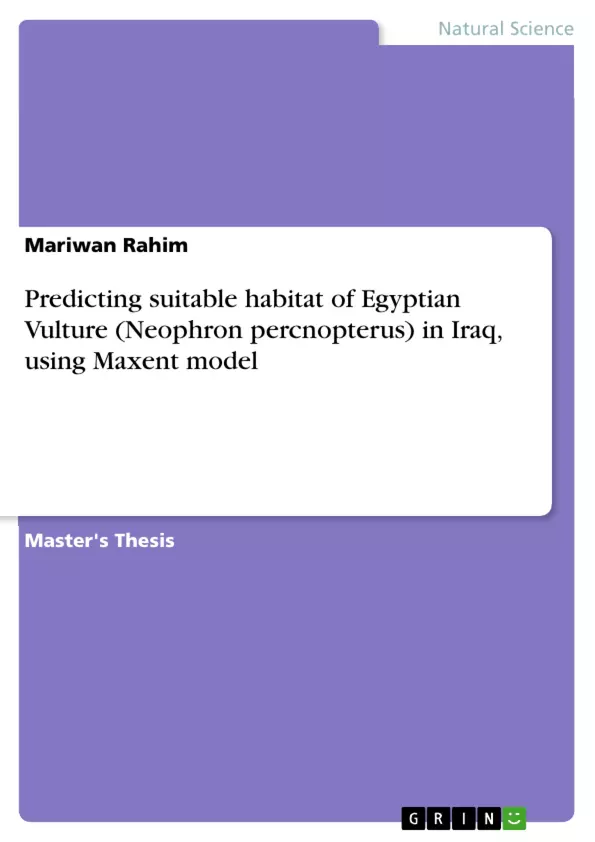Species distribution modeling to predict and map appropriate habitat for endangered species is critical for monitoring and restoration of their population decline in natural habitat. However, data on distribution of endangered species are limited. Egyptian Vulture (Neophron percnopterus) is one of the endangered species in the world that its population has been declining by 50% in the last three decade.
In this study, we have tried to test the predicted distribution of potentially suitable habitat for Egyptian Vulture in Iraq by using Maxent as species distribution model. To achieve these aims, we could be done with species distribution model outputs of Egyptian Vulture from occurrence data assembled from Nature Iraq and made distribution predictions, demonstrating how landscape and environmental variables may affect the species distribution and we determined their importance and compared known habitat of Egyptian Vulture from KBAs with predicted habitat predictions from Maxent.
The model performed very well. The AUC value is 0.870, which is better than random prediction. The results indicate that one of the precipitation inputs, bio_13, contributed 54.3% to the final description of potential habitat for the Egyptian Vulture. This provides evidence that precipitation, particularly precipitation of wettest month, is the most significant variable in the model’s determination of suitable habitat locations. Several of the highest suitability points predicted by Maxent are associated with known Egyptian Vulture presence and some of them match with KBAs. But, there are a number of locations, which were predicted to have high suitability of habitat for Egyptian Vulture, are located outside KBAs.
This study is important to do more fieldwork for predicted high suitable area for Egyptian Vulture in the future and protect them from population decline.
Inhaltsverzeichnis (Table of Contents)
- Abstract
- Chapter 1: Introduction
- Chapter 2: Methods
- 2.1.The Study area:
- 2.2.The Egyptian Vulture:
- 2.2.1 Ecology and Habitat Description of Egyptian Vulture
- 2.3.Occurrence data:
- 2.4.Environmental data
- 2.5.Data Analysis
- 2.5.1 Developing the model
- 2.5.2 Maxent
- 2.5.3 Maxent output data format
- 2.5.4 Model evaluation
- Chapter 3: Result
- 3.1.Response Curves results:
- 3.2. Jackknife results:
- Chapter 4: Discussion
- 4.1. Response Curve and Environmental Variables contribution
- 4.2.Conclusion
- 4.3.Conservation Implication
- Acknowledgement
- Reference
Zielsetzung und Themenschwerpunkte (Objectives and Key Themes)
This study aims to predict the potential suitable habitat for the Egyptian Vulture in Iraq by using Maxent as a species distribution model. The study uses occurrence data records of the Egyptian Vulture to create ecological models, focusing on Iraq generally and Kurdistan Region particularly. The analysis explores how landscape and environmental variables affect the species distribution. The study also aims to determine the importance of these variables and compare known habitats of the Egyptian Vulture with the predicted habitats.
- Predicting the suitable habitat of the Egyptian Vulture in Iraq using Maxent modeling.
- Analyzing the influence of landscape and environmental variables on the species distribution.
- Assessing the importance of environmental variables in determining suitable habitats.
- Comparing predicted habitats with known habitats of the Egyptian Vulture from Key Biodiversity Areas.
- Exploring the implications of the model for conservation efforts.
Zusammenfassung der Kapitel (Chapter Summaries)
Chapter 1 introduces the study, highlighting the importance of species distribution modeling for conservation efforts, particularly for endangered species like the Egyptian Vulture. The chapter also discusses the decline of the Egyptian Vulture population worldwide, the factors contributing to this decline, and the advantages and disadvantages of using Maxent for species distribution modeling.
Chapter 2 describes the methods used in the study. This includes information on the study area, Iraq, its environmental characteristics, and the Egyptian Vulture, including its ecology and habitat preferences. The chapter also outlines the data sources used for occurrence records and environmental variables, as well as the Maxent modeling process and the model evaluation methods.
Chapter 3 presents the results of the study, including the performance of the Maxent model in predicting suitable habitats for the Egyptian Vulture in Iraq, the contribution of various environmental variables to the model, and the comparison of predicted habitats with known habitats.
Schlüsselwörter (Keywords)
The key terms and concepts of the study include species distribution modeling, Maxent model, Egyptian Vulture (Neophron percnopterus), suitable habitat, environmental variables, precipitation, land cover, altitude, conservation, Iraq, Kurdistan Region, Key Biodiversity Areas, and presence-only data.
- Quote paper
- Mariwan Rahim (Author), 2014, Predicting suitable habitat of Egyptian Vulture (Neophron percnopterus) in Iraq, using Maxent model, Munich, GRIN Verlag, https://www.grin.com/document/321923



